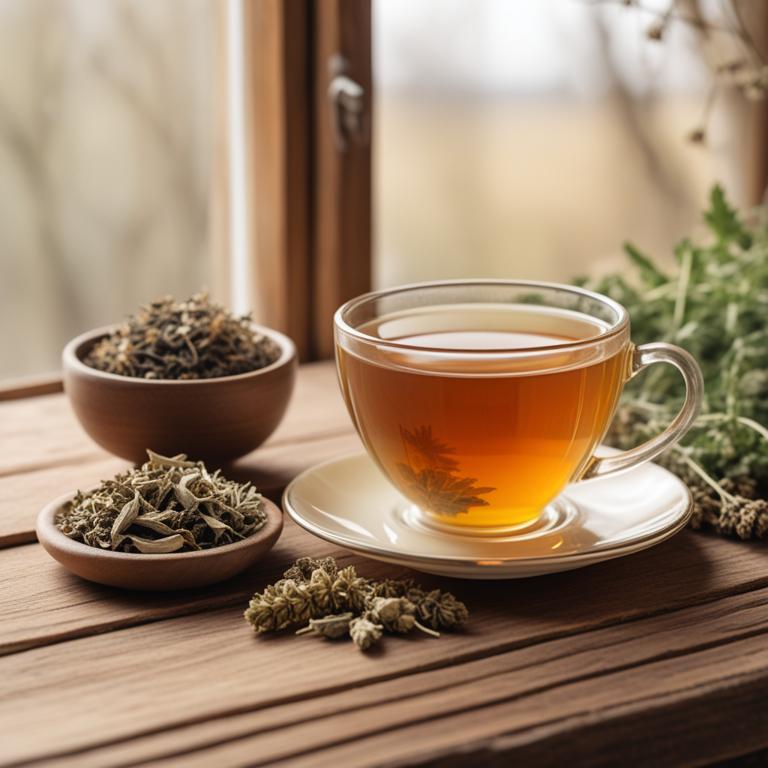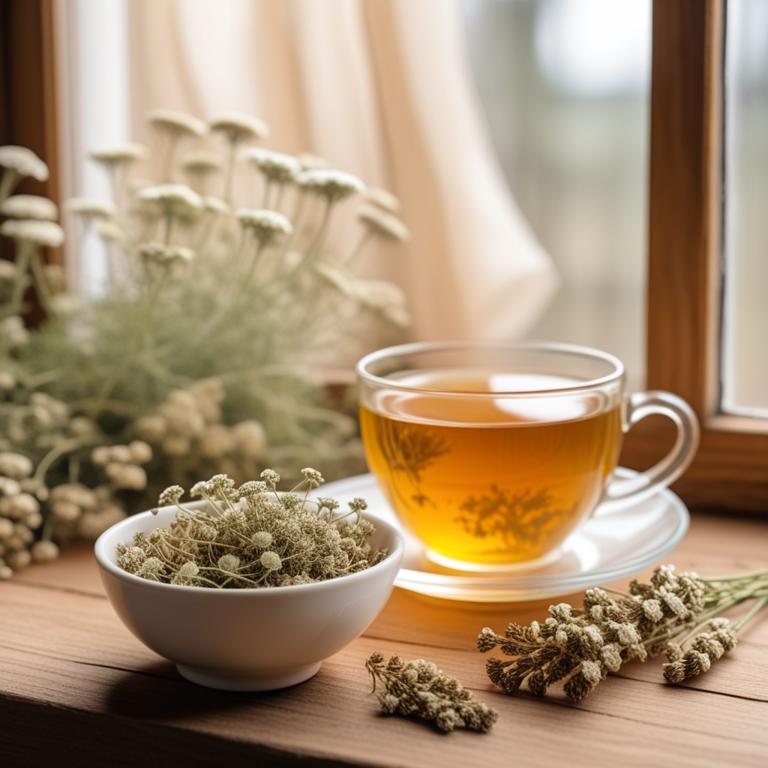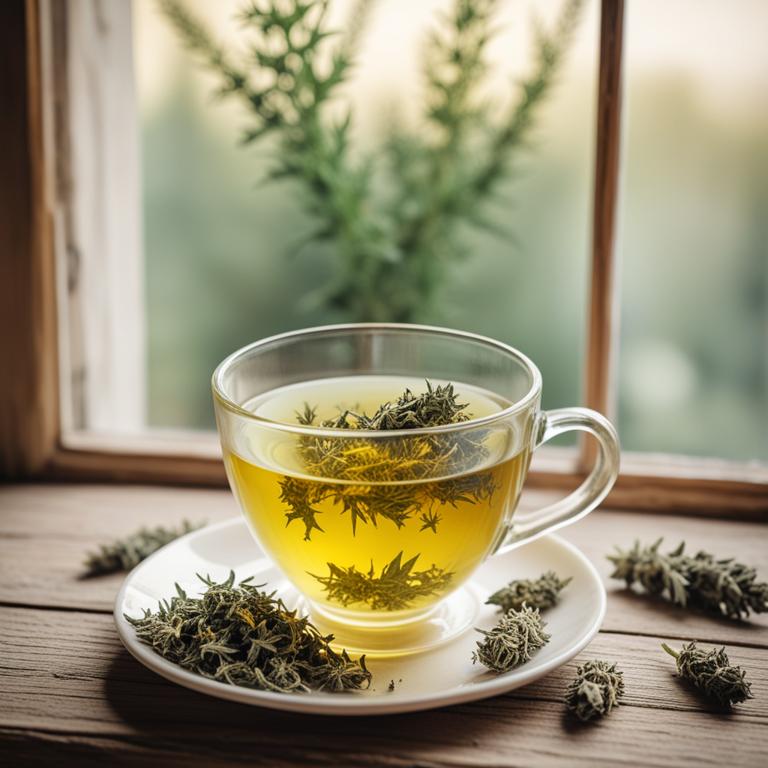13 Best Herbal Teas For Back Pain

Herbal teas for back pain are a natural and holistic approach to alleviating discomfort and inflammation in the muscles and joints.
These teas are often used to treat back pain due to their anti-inflammatory and analgesic properties, which help to soothe and calm the body.
Examples of herbal teas that can be used to treat back pain include Ginger tea, which reduces inflammation and relieves muscle spasms; Turmeric tea, which contains curcumin that has potent anti-inflammatory and antioxidant properties; Willow Bark tea, which contains salicin that has analgesic and anti-inflammatory effects; Peppermint tea, which relaxes muscles and reduces tension; Chamomile tea, which calms the mind and body; and Lavender tea, which promotes relaxation and reduces stress.
Additionally, teas like Rosemary, Thyme, and Eucalyptus can also be used to treat back pain due to their anti-inflammatory and decongestant properties.
Related Study
According to the study, teas for back pain, particularly green tea, may be an effective and safe treatment due to its antinociceptive effects, antioxidant, and anti-inflammatory properties, especially attributed to the presence of epigallocatechin-3-gallate (EGCG).
Below there's a list of the 13 best herbal teas for back pain.
Table of Contents
- 1. Curcuma longa teas
- 2. Glycyrrhiza glabra teas
- 3. Zingiber officinale teas
- 4. Valeriana officinalis teas
- 5. Lavandula angustifolia teas
- 6. Ginkgo biloba teas
- 7. Camellia sinensis teas
- 8. Achillea millefolium teas
- 9. Silybum marianum teas
- 10. Piper nigrum teas
- 11. Vitex agnus-castus teas
- 12. Artemisia absinthium teas
- 13. Catha edulis teas
Also, you may be interested in...
Today Free Bonus!
The Ultimate Herb Drying Checklist
(For Long-Lasting Powerful Medicinal Effect)
How to easily dry herbs that don't mold and that keep their strong medicinal power for more than 1 year.
1. Curcuma longa teas

Curcuma longa teas, made from the turmeric plant, have been widely used to treat back pain due to its anti-inflammatory and analgesic properties.
The bioactive constituents, including curcumin, demethoxycurcumin, and bisdemethoxycurcumin, help to reduce inflammation and alleviate pain by inhibiting the production of pro-inflammatory enzymes and cytokines.
By reducing inflammation and pain, Curcuma longa teas provide relief from back pain, improve mobility, and enhance the overall quality of life.
The benefits of using Curcuma longa teas to treat back pain include reduced reliance on pain medications, improved sleep quality, and long-term prevention of chronic back pain.
Related Study
According to "Current rheumatology reviews", Curcuma longa teas containing curcumin, a strong antioxidant, may have potential medicinal benefits for back pain caused by osteoarthritis due to its anti-inflammatory properties that can help slow the progression of the condition.
Recipe:
- Get 1 cup of water and boil it in a pot.
- Add 1/2 teaspoon of dried Turmeric root (Curcuma longa) to the boiling water.
- Reduce the heat to low and let it simmer for 5-7 minutes.
- Strain the tea into a cup and add 1 tablespoon of honey to taste.
- Drink the tea 2-3 times a day to help alleviate back pain.
Curcuma longa teas can be an effective treatment for back pain, but it may also cause side effects such as stomach upset, nausea, and diarrhea due to its high polyphenol content and potential interaction with medications.
To minimize risks, it is recommended to start with a low dose, gradually increasing it as needed, and to avoid using Curcuma longa teas in conjunction with other blood-thinning medications or with conditions such as bleeding disorders or ulcers.
Curcuma Longa Tea on Amazon
Pure Ceylon Turmeric Brew - 100% Organic Ceylon Turmeric Tea Bags (40 Sachets - pack of 2 – 20 COUNT PER BOX)
Disclaimer: We earn a commission if you click this link and make a purchase at no additional cost to you.
2. Glycyrrhiza glabra teas

Glycyrrhiza glabra teas, a traditional herbal remedy, have been used to treat back pain due to their anti-inflammatory and analgesic properties.
The bioactive constituents of Glycyrrhiza glabra, including glycyrrhizin, flavonoids, and phenolic acids, help to reduce pain and inflammation in the muscles and joints.
By inhibiting the production of pro-inflammatory enzymes and promoting the release of pain-relieving neurotransmitters, Glycyrrhiza glabra teas provide relief from back pain and improve overall well-being.
Regular consumption of Glycyrrhiza glabra teas has been shown to reduce the severity and frequency of back pain episodes, making it a beneficial herbal preparation for individuals suffering from this common ailment.
Recipe:
- Gather 2 tablespoons of dried Glycyrrhiza glabra roots, 1 cup of water, and a strainer.
- Boil the water in a pot and remove from heat.
- Add the dried roots to the hot water and let it steep for 5-7 minutes.
- Strain the mixture into a cup and discard the roots.
- Drink the tea 2-3 times a day to help with back pain.
Glycyrrhiza glabra teas can be effective in treating back pain due to its anti-inflammatory properties, but possible side effects may include sodium retention, which can lead to high blood pressure and swelling in the feet and ankles.
To use Glycyrrhiza glabra teas safely, it is recommended to consume them in moderation and to be mindful of their potential interactions with other medications, especially blood pressure medications and diuretics, and to also monitor blood pressure regularly.
Glycyrrhiza Glabra Tea on Amazon
Pukka Herbal Teas Licorice and Cinnamon - 20 Bags, 20 Count
Disclaimer: We earn a commission if you click this link and make a purchase at no additional cost to you.
3. Zingiber officinale teas

Zingiber officinale teas, also known as ginger teas, have been traditionally used to treat back pain due to their anti-inflammatory and analgesic properties.
The bioactive constituents of ginger, such as gingerols and shogaols, help to reduce pain and inflammation by inhibiting the production of pro-inflammatory enzymes.
The consumption of ginger teas has been shown to provide relief from back pain by reducing muscle spasms and improving blood circulation, which in turn helps to reduce pain and stiffness.
Regular consumption of ginger teas may also provide long-term benefits by reducing chronic inflammation and promoting overall well-being.
Related Study
According to this study, Zingiber officinale teas for back pain may be beneficial due to its anti-inflammatory, analgesic activity, and antinociceptive properties, which are known to manage sciatic pain.
Recipe:
- Gather 1 tablespoon of dried Zingiber officinale root and 1 cup of boiling water.
- Add the dried Zingiber officinale root to a cup.
- Pour the boiling water over the root in the cup.
- Let the mixture steep for 5-7 minutes, then strain the liquid.
- Drink 1 cup of the tea, 2-3 times a day, to help relieve back pain.
Zingiber officinale teas can be used to treat back pain, but possible side effects include nausea, dizziness, and stomach upset due to its active compounds that may interact with certain medications or exacerbate pre-existing conditions.
To use Zingiber officinale teas safely, take precautions such as starting with a low dose, avoiding consumption before surgery, and being cautious when mixing with other herbal remedies or medications that thin the blood.
Zingiber Officinale Tea on Amazon
FGO Organic Ginger Tea, 100 Count, Eco-Conscious Tea Bags, Caffeine Free, Packaging May Vary (Pack of 1)
Disclaimer: We earn a commission if you click this link and make a purchase at no additional cost to you.
4. Valeriana officinalis teas

Valeriana officinalis teas have been widely used as a natural remedy to treat back pain due to their sedative, anti-inflammatory, and analgesic properties.
The valerenic acid and valeranone present in this herbal preparation help to reduce muscle spasms and inflammation, thereby alleviating back pain.
The bioactive constituents, including valepotriates, valeoptenol, and valerenic acid, interact with the GABA receptors in the brain, promoting relaxation and reducing pain perception.
Regular consumption of Valeriana officinalis teas has been shown to provide long-term relief from back pain, improve sleep quality, and enhance overall well-being.
Recipe:
- Gather 2 tablespoons of dried Valeriana officinalis root.
- Heat 1 cup of water in a pot until it starts boiling.
- Add the dried root to the boiling water and reduce heat to low.
- Steep the mixture for 5-7 minutes and then strain it.
- Drink the tea warm or at room temperature, up to 3 times a day.
Valeriana officinalis teas can be used to treat back pain, but possible side effects may include drowsiness, stomach upset, and allergic reactions such as skin rashes or itching.
To use Valeriana officinalis teas safely, take it in moderation, avoid consuming it before driving or operating heavy machinery, and be cautious when combining it with other sedatives or medications, especially those used to treat anxiety or sleep disorders.
Valeriana Officinalis Tea on Amazon
Frontier Co-op Cut and Sifted Valerian Root 1lb, Kosher - for Valerian Root Tea, DIY Supplement Capsules, Bedtime Formulas and Sleep Pillows
Disclaimer: We earn a commission if you click this link and make a purchase at no additional cost to you.
5. Lavandula angustifolia teas

Lavandula angustifolia teas, also known as English lavender tea, have been traditionally used to alleviate back pain due to their analgesic and anti-inflammatory properties.
The bioactive constituents present in this herbal preparation, including linalool and linalyl acetate, help to reduce pain and inflammation by interacting with the nervous system and blocking the production of pain-causing chemicals.
By promoting relaxation, reducing muscle spasms, and improving sleep quality, Lavandula angustifolia teas help to treat back pain by addressing its underlying causes.
The benefits of using Lavandula angustifolia teas to treat back pain include reduced pain and discomfort, improved sleep quality, and enhanced overall well-being.
Recipe:
- Gather ingredients: 1 cup of boiling water, 1 tablespoon of dried Lavandula angustifolia flowers.
- Measure 1 teaspoon of dried Lavandula angustifolia flowers. Place in a tea infuser or a small muslin bag.
- Pour 1 cup of boiling water over the Lavandula angustifolia flowers. Let it steep for 5-7 minutes.
- Strain the tea into a cup. Discard the flowers.
- Drink the tea 2-3 times a day to help with back pain relief. Store any leftover tea in the fridge for up to 24 hours.
Lavandula angustifolia teas can help alleviate back pain by reducing inflammation and promoting relaxation, but possible side effects may include dizziness, nausea, and allergic reactions in some individuals.
When using Lavandula angustifolia teas to treat back pain, it is essential to be cautious of interactions with other medications, such as blood thinners, and to start with small doses to avoid stomach upset.
Lavandula Angustifolia Tea on Amazon
Tiesta Tea - Lavender Chamomile Herbal Tea | Loose Leaf | Calming Blend with Chamomile and Lavender | Caffeine-Free Herbal | Great for Hot or Iced Brews | Resealable Bulk Pouch, 200 Cups | 8 Ounce
Disclaimer: We earn a commission if you click this link and make a purchase at no additional cost to you.
6. Ginkgo biloba teas

Ginkgo biloba teas have been traditionally used to treat back pain, a common ailment affecting millions of people worldwide.
The anti-inflammatory and antioxidant properties of this herbal preparation help to reduce pain and inflammation in the muscles and joints, making it an effective treatment for back pain.
The bioactive constituents of Ginkgo biloba, including flavonoids and terpenoids, work together to reduce oxidative stress and improve blood flow to the affected areas, which in turn helps to alleviate back pain.
The benefits of using Ginkgo biloba teas to treat back pain include reduced pain and inflammation, improved mobility, and a reduction in the reliance on pain medication, making it a popular natural remedy for this common condition.
Recipe:
- Get 1 cup of boiling water
- Measure 1 teaspoon of dried Ginkgo biloba leaves and put them in a tea infuser
- Steep the Ginkgo biloba leaves in the boiling water for 5-7 minutes
- Strain the tea into a cup and add honey to taste
- Drink the tea 2-3 times a day to help with back pain relief
Ginkgo biloba teas can be effective in alleviating back pain symptoms, but possible side effects may include dizziness, headaches, and stomach upset due to its blood-thinning properties.
To minimize potential side effects, it is recommended to start with low doses and gradually increase as needed, avoid taking Ginkgo biloba teas with other medications that also thin the blood, and be cautious when engaging in activities that require balance and coordination.
Ginkgo Biloba Tea on Amazon
Tai Chi Think Sharp Energizing Tea (Ginseng Ginkgo Biloba) 12 Bags
Disclaimer: We earn a commission if you click this link and make a purchase at no additional cost to you.
7. Camellia sinensis teas

Camellia sinensis teas, derived from the leaves of the Camellia sinensis plant, have been traditionally used to treat back pain due to their anti-inflammatory and analgesic properties.
The herbal preparation contains bioactive constituents such as flavonoids, catechins, and theophylline, which help to reduce inflammation and alleviate pain in the back.
The anti-inflammatory properties of Camellia sinensis teas help to reduce swelling and ease muscle tension, making them a potential natural remedy for back pain relief.
Regular consumption of Camellia sinensis teas has been shown to provide benefits in terms of pain management, improved flexibility, and enhanced overall well-being.
Related Study
According to the scientific study, Camellia sinensis teas, specifically green tea, may provide an effective and safe treatment for back pain due to its antioxidant and anti-inflammatory properties, particularly through the action of epigallocatechin-3-gallate (EGCG) in suppressing inflammation and oxidative stress.
Recipe:
- Gather 1 teaspoon of Camellia sinensis leaves (black, green, or oolong) and 1 cup of boiling water.
- Steep the leaves in the boiling water for 3-5 minutes for black tea, 2-3 minutes for green tea, or 5-7 minutes for oolong tea.
- Strain the tea into a cup using a tea strainer or a piece of cheesecloth.
- Add 1-2 teaspoons of honey (optional) and 1/2 cup of milk or creamer (optional) to the tea.
- Drink the tea slowly and comfortably, and consider repeating the process every 2-3 hours to help manage back pain.
Camellia sinensis teas can be a potential remedy for back pain relief, but they may cause side effects such as dizziness, headaches, and stomach upset in some individuals, particularly when consumed in excess or combined with other medications.
To minimize the risk of adverse effects, it is essential to drink Camellia sinensis teas in moderation, avoid mixing them with other stimulants, and pay attention to individual tolerance levels, as some people may experience allergic reactions or interact with certain health conditions.
Camellia Sinensis Tea on Amazon
Ito En Traditional Matcha Green Tea 50 Count Zero Calories, Caffeinated
Disclaimer: We earn a commission if you click this link and make a purchase at no additional cost to you.
8. Achillea millefolium teas

Achillea millefolium teas have been traditionally used to treat back pain due to their anti-inflammatory and analgesic properties, which help to reduce inflammation and alleviate pain associated with the condition.
The bioactive constituents of this herbal preparation, including sesquiterpene lactones and polyacetylenes, play a crucial role in its therapeutic effects by inhibiting the production of pro-inflammatory enzymes and modulating the activity of neurotransmitters involved in pain perception.
By using Achillea millefolium teas, individuals can experience relief from back pain due to its ability to relax muscles, reduce muscle spasms, and improve sleep quality, leading to overall well-being.
The benefits of using Achillea millefolium teas to treat back pain include reduced reliance on pharmaceutical medications, improved quality of life, and a natural approach to managing chronic pain.
Recipe:
- Gather 1 cup of dried Achillea millefolium flowers.
- Measure 1 tablespoon of dried flowers and place them in a tea infuser.
- Heat 1 cup of water in a pot and bring it to a boil.
- Pour the boiling water over the tea infuser and let it steep for 5-7 minutes.
- Strain the tea and drink it warm, 2-3 times a day for back pain relief.
Achillea millefolium teas can be used to treat back pain due to its anti-inflammatory properties, but possible side effects include nausea, dizziness, and stomach upset, especially when consumed in large quantities or for extended periods.
To minimize potential side effects, it is recommended to start with a low dose and gradually increase as needed, and to avoid drinking Achillea millefolium teas before bedtime or when engaging in activities that require alertness.
Achillea Millefolium Tea on Amazon
Biokoma Pure and Organic Yarrow Dried Herb 30 Tea Bags 1.5oz In Resealable Moisture Proof Pouch, USDA Certified Organic - Herbal Tea, No Additives, No Preservatives, No GMO, Kosher
Disclaimer: We earn a commission if you click this link and make a purchase at no additional cost to you.
9. Silybum marianum teas

Silybum marianum teas, also known as milk thistle tea, have been traditionally used to treat back pain due to its anti-inflammatory and analgesic properties.
The bioactive constituents of Silybum marianum, including silymarin and flavonoids, help to reduce inflammation and alleviate pain by blocking the production of pro-inflammatory enzymes and neurotransmitters.
By consuming Silybum marianum teas, individuals may experience relief from back pain, as the herbal preparation helps to relax muscles, improve blood circulation, and reduce muscle spasms, ultimately leading to improved mobility and reduced discomfort.
The benefits of using Silybum marianum teas to treat back pain include reduced reliance on pharmaceuticals, minimal side effects, and a natural approach to managing chronic pain.
Recipe:
- Gather 1 cup of fresh Silybum marianum leaves and flowers.
- Rinse the herbs with clean water and pat them dry with a paper towel.
- Use 1 tablespoon of dried Silybum marianum or 2 tablespoons of fresh herbs for every cup of boiling water.
- Pour boiling water over the herbs in a cup and let it steep for 5-7 minutes.
- Strain the tea and drink it slowly, ideally 2-3 times a day for back pain relief.
Silybum marianum teas can be used to treat back pain, but it may cause side effects such as stomach upset, diarrhea, and allergic reactions in some individuals.
When using Silybum marianum teas for back pain, it is recommended to start with a low dose, gradually increase it, and monitor your body's response to avoid potential side effects like nausea and dizziness.
Silybum Marianum Tea on Amazon
Celebration Herbals Organic Milk Thistle Seed Herbal Tea -- 24 Tea Bags, NET WT.60, 2.11 OZ
Disclaimer: We earn a commission if you click this link and make a purchase at no additional cost to you.
10. Piper nigrum teas

Piper nigrum teas, derived from the dried unripe fruit of the black pepper vine, have been traditionally used to treat back pain due to their analgesic and anti-inflammatory properties.
The bioactive constituents, including piperine, piperonal, and limonene, help to reduce inflammation, relieve pain, and relax muscles.
By inhibiting the production of prostaglandins and reducing muscle spasms, Piper nigrum teas provide relief from chronic back pain, improving the quality of life for those affected.
The benefits of this herbal preparation include reduced pain, improved sleep, and enhanced overall well-being, making it a valuable natural remedy for back pain treatment.
Recipe:
- Gather 1 cup of water and 2 tablespoons of dried Piper nigrum (black pepper) in a saucepan.
- Bring the water to a boil over medium heat.
- Reduce heat and add the dried Piper nigrum. Let it simmer for 5-7 minutes.
- Strain the mixture into a cup using a tea strainer or cheesecloth.
- Drink the tea 2-3 times a day, as needed, for back pain relief.
Piper nigrum teas can be used to treat back pain, but it may cause side effects such as stomach upset, nausea, and diarrhea due to its high piperine content.
To avoid these side effects, it is recommended to start with a low dose and gradually increase it, and to avoid consuming the tea on an empty stomach and with certain medications like blood thinners and antacids.
11. Vitex agnus-castus teas

Vitex agnus-castus teas have been traditionally used to help alleviate back pain due to their anti-inflammatory and analgesic properties, which help to reduce swelling and relieve pain.
This herbal preparation contains bioactive constituents such as aucubin, agnuside, and ursolic acid, which are responsible for its therapeutic effects.
Vitex agnus-castus teas work by modulating the body's hormonal balance, particularly the levels of estrogen and progesterone, which can contribute to back pain in women.
The benefits of using Vitex agnus-castus teas for back pain include reduced inflammation, improved sleep quality, and a decrease in the frequency and severity of back pain episodes.
Recipe:
- Gather 1 teaspoon of dried Vitex agnus-castus herb and 1 cup of boiling water.
- Steep the herb in the boiling water for 5-7 minutes.
- Strain the mixture into a cup and discard the herb.
- Add 1 tablespoon of honey (optional) to the tea and stir well.
- Drink the tea 2-3 times a day to help alleviate back pain.
Vitex agnus-castus teas can be an effective remedy for treating back pain, but possible side effects include dizziness, headaches, and stomach upset due to its hormone-balancing properties, which may interact with other medications or worsen certain conditions.
To use this herbal preparation safely, take small amounts, avoid consuming it with other medications, and be cautious if you have a history of hormonal imbalances or are pregnant.
12. Artemisia absinthium teas

Artemisia absinthium teas have been traditionally used to treat back pain due to their analgesic, anti-inflammatory, and antispasmodic properties.
These teas help to alleviate back pain by reducing inflammation, relaxing muscles, and soothing the nervous system.
The bioactive constituents present in Artemisia absinthium, such as thujone, sesquiterpenes, and flavonoids, contribute to its therapeutic effects by inhibiting the production of pro-inflammatory enzymes and promoting the release of neurotransmitters that reduce pain perception.
The benefits of using Artemisia absinthium teas to treat back pain include reduced discomfort, improved mobility, and a decrease in the reliance on pharmaceutical painkillers.
Recipe:
- Gather 2 tablespoons of dried Artemisia absinthium leaves.
- Steep the leaves in 1 cup of boiling water for 5-7 minutes.
- Strain the mixture through a fine-mesh sieve or cheesecloth.
- Add honey or sugar to taste, if desired.
- Drink the tea 2-3 times a day for relief from back pain.
Artemisia absinthium teas can be used to treat back pain, but its use may lead to side effects such as dizziness, nausea, and headaches due to its high concentration of thujone, a potentially toxic compound.
To minimize risks, individuals should start with small doses, avoid consuming large quantities, and be cautious when combining it with other medications or substances that may interact with its active compounds.
13. Catha edulis teas

Catha edulis teas, also known as khat, have been traditionally used to treat back pain ailments due to their analgesic and anti-inflammatory properties.
The bioactive constituents of Catha edulis, including cathinone and cathine, help to reduce pain and inflammation in the body, providing relief from back pain.
The anti-inflammatory properties of Catha edulis teas also help to reduce muscle spasms and improve joint mobility, making it a potential natural remedy for back pain.
The benefits of using Catha edulis teas to treat back pain include reduced reliance on pain medication, improved overall health, and a natural approach to pain management.
Recipe:
- Gather Catha edulis leaves and dried flowers (about 2 tablespoons). Clean and dry them.
- Boil 1 cup of water in a pot. Remove from heat when it starts boiling.
- Add the Catha edulis leaves and dried flowers to the boiling water. Let it steep for 5-7 minutes.
- Strain the mixture using a tea strainer or a piece of cloth into a cup. Discard the solids.
- Drink the tea while it's warm. You can add honey or lemon to taste.
Catha edulis teas can be used to treat back pain, but possible side effects may include increased heart rate, insomnia, and anxiety due to the presence of cathinone, a stimulant compound found in the plant.
Precautions should be taken to avoid consuming excessive amounts, as this may lead to dependence and other adverse reactions, such as tremors and mood swings.